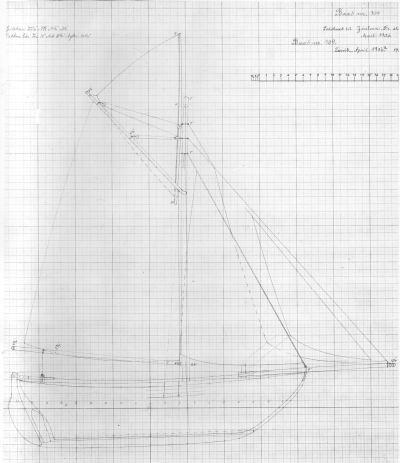Original
Colin Archer Plans:
There
are plans of rescue boats, pilot cutters, fishing boats and
yachts.
Some of the yachts do not look like what one would
think of as a Colin Archer as they have counter sterns and are
narrow like the English cutters of the last century.
The
plans consist of, usually a linesplan, a sailplan and an interior
layout.
CA’s
early
linesplans
are
really messy, but the later linesplans are nicely drawn but
sometimes traced.
(Be aware that the diagonals are not
lead
to the centre-line crossing waterlines). There is no offset table,
or any construction plan or scantlings.
The stern needs an
extensive redesign to successfully fit a propeller and to retain
the good maneuverability inherent in the original design.
Be also aware that many of CA designs, as the one shown here, have too little displacement for today's fitting-out with an engine and tanks for offshore cruising. Many designs are sharp in the ends and can thus be very “pitchy” if loaded in either end with anchor chains, tanks, batteries and whatever we can put in a boat these days.

Originally there were no detailed construction plans. The boats were designed by the shipyard and details did not have to be put down on paper. Today, however, it is very important to have all the details on scantlings and construction since the boat is probably going to be built by a yard not familiar with this design.
The original interior layouts are not functional for today's use. Times have changed!
The CA sailplan can sometimes be used, like the pilot boat plan show to the right. However, today we usually use lager jibs and a taller mast so the topsail yard can be shorter.
The rescue boat ketch rig has little sail as it is designed to gale force winds. This rig has to enlarged for yacht use.
The yachts have large sail areas often with a longer mainsail boom than we like these days.
as we do more offshore cruising than we did before. Today these boats are not designed to be modern racing boats and can carry an engine for use in calm conditions. A long boom often creates a weather helm which worsens when the rudder is cut out to accommodate the propeller. The shorter yacht booms and reduced sail area is usually compensated by a taller rig and a larger jib.
There are seldom scantlings on the spars. Diameters must not be taken from the sailplan!

Too many Colin Archer replicas or copies, despite the heavy scantlings, suffer from inadequate strength.
The sailplan can sometimes be
used. However, the rescue boats have little sail area and have to
enlarge the rig for yacht use.
The yachts have large sail
areas but often a longer mainsail booms than we like today when we
do more offshore cruising than before.
Today these boats are
not modern racing boats and we also have engine for use in calm
conditions.
The long boom often creates a weather helm which
becomes even worse when the rudder is cut out for the propeller.
The shorter yacht booms and reduces sail area is usually
compensated for with a taller rig and larger jib.
There are
seldom scantlings on the spars. Diameters must not be taken from
the sailplan!
If you want advice on Colin Arhers plans, you can
call me or mail me.
This
will be on commercial basis, 1 € (euro)
pr minute, phone or mail.
The original plans can be obtained from
the Maritime Museum in Oslo:
Norsk
Sjøfartsmuseum, Bygdønesveien
37, 0286 Oslo - Norway
Tlph + 47 2411
4150 - Fax + 47 2411
4151
http://www.marmuseum.no/
